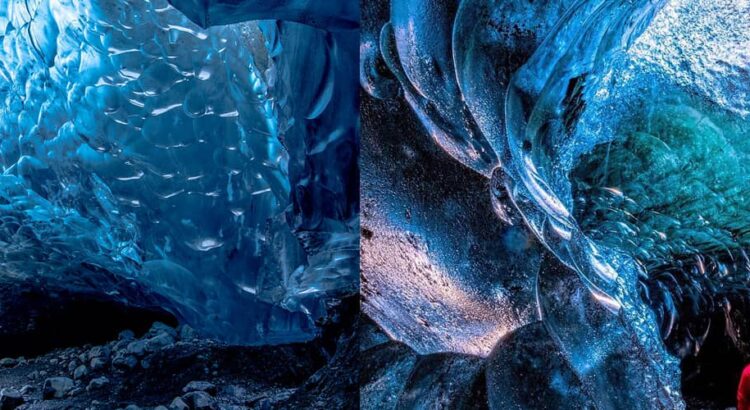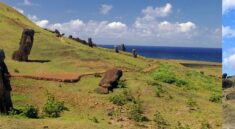Breiðamerkurjökull, a prominent outlet glacier extending from the vast Vatnajökull ice cap in Iceland, stands as a stunning testament to the country’s glacial wonders. This glacier is part of the larger Vatnajökull National Park, Europe’s largest national park, and it encompasses diverse and captivating features that attract visitors from around the world.
Breiðamerkurjökull is situated in the southeastern region of Iceland, and its ever-shifting icy expanse spans approximately 6 kilometers in width. Nestled within the confines of Vatnajökull, it flows inexorably toward the Atlantic Ocean, offering a dynamic spectacle of ice and natural grandeur.
One of the most iconic and picturesque aspects of Breiðamerkurjökull is the creation of the Jökulsárlón Glacier Lagoon. As the glacier steadily recedes, glacial meltwater accumulates, forming an expansive lagoon dotted with icebergs of varying shapes and sizes. The vivid blue hues of the ice juxtaposed against the serene waters create a breathtaking visual feast, making Jökulsárlón one of Iceland’s must-visit destinations.
How to get there
Getting to Breiðamerkurjökull involves traveling to the southeastern region of Iceland, specifically within the expansive Vatnajökull National Park. The proximity of the glacier to the Ring Road (Route 1) makes it relatively accessible, and several transportation options are available. Here’s how to get to Breiðamerkurjökull:
- By Car:
- From Reykjavik: Start your journey from Reykjavik, the capital of Iceland. Drive east on the Ring Road (Route 1), the main highway that circumnavigates the country.
- Route Details: Follow Route 1 as it passes through diverse landscapes, including lava fields and coastal areas. You will eventually reach the Vatnajökull National Park in the southeast.
- Tours and Guided Excursions:
- Consider joining a guided tour or excursion to Breiðamerkurjökull. Many tour operators offer day trips from Reykjavik or nearby towns, providing transportation, guided experiences, and sometimes additional activities such as ice cave exploration.
- Guided tours can enhance your experience by providing insights into the glacial environment and ensuring a safe exploration of the area.
- Public Transportation:
- Public transportation options to Breiðamerkurjökull are limited. However, there are bus services that operate along the Ring Road, connecting major towns and attractions.
- Check the schedule and availability of bus services that may pass through or near Vatnajökull National Park.
- Domestic Flights:
- While there are no airports directly adjacent to Breiðamerkurjökull, you can fly to nearby towns such as Höfn in Hornafjörður. From there, you can use ground transportation to reach the glacier.
- Domestic flights are available from Reykjavik to regional airports.
Important Considerations:
- Road Conditions: Check road conditions, especially during winter, as weather and road conditions can change rapidly. The southeast region may experience snow and ice, so having a suitable vehicle or joining a tour with experienced drivers is advisable.
- Tours and Guides: If you’re not comfortable driving or prefer a guided experience, tours are a convenient option. Guides can provide valuable information about the glacier and ensure your safety.
Things to do
Exploring Breiðamerkurjökull and its surrounding areas offers a range of exciting activities and experiences, providing visitors with a unique opportunity to immerse themselves in the breathtaking landscapes of this Icelandic glacier. Here are some recommended things to do:
- Jökulsárlón Glacier Lagoon:
- Marvel at the stunning Jökulsárlón Glacier Lagoon, where icebergs calve from the glacier and float serenely in the glacial waters. Consider taking a boat tour to get up close to the icebergs and learn about the glacier’s dynamic nature.
- Diamond Beach:
- Visit Diamond Beach, located nearby, where icebergs that have drifted from the lagoon wash ashore, creating a mesmerizing scene. The juxtaposition of glistening ice against black volcanic sand makes for spectacular photography.
- Ice Cave Exploration:
- Experience the otherworldly beauty of an ice cave. Guided ice cave tours are available, allowing you to venture into the heart of the glacier and witness the intricate blue hues of the ice.
- Photography and Sightseeing:
- Capture the breathtaking landscapes with your camera. The ever-changing ice formations, the glacial lagoon, and the surrounding mountains provide ample opportunities for photography.
- Hiking and Nature Walks:
- Explore the hiking trails around Vatnajökull National Park. While hiking directly on the glacier may require specialized equipment and expertise, there are various trails offering panoramic views of the glacier and the surrounding wilderness.
- Northern Lights Viewing:
- During the winter months, witness the magical display of the Northern Lights (Aurora Borealis) if the conditions are right. The dark skies in the area make it an ideal spot for aurora viewing.
- Birdwatching:
- Vatnajökull National Park is home to diverse bird species. Birdwatchers can enjoy spotting seabirds, including puffins, as well as other avian residents in the region.
- Visit Nearby Towns:
- Explore nearby towns such as Höfn in Hornafjörður, known for its fishing culture and local cuisine. Sample fresh seafood or immerse yourself in the unique charm of Icelandic villages.
- Educational Centers:
- Visit educational centers or visitor facilities within Vatnajökull National Park to learn more about the glacier’s formation, geological features, and the impact of climate change on glaciers.
- Glacier Tours and Guides:
- Join guided glacier tours led by experienced guides who can provide insights into the geological wonders, safety precautions, and the environmental significance of glaciers.
Before engaging in any activities, check with local tour operators, visitor centers, or authorities for up-to-date information on conditions and availability. Embrace the natural beauty of Breiðamerkurjökull and its surroundings while respecting the fragility of the glacial environment.
Things not to forget
When visiting Breiðamerkurjökull and the surrounding areas, it’s essential to be well-prepared to ensure a safe and enjoyable experience. Here’s a list of things not to forget:
- Weather-Appropriate Clothing:
- Dress in layers and wear weather-appropriate clothing. The weather in Iceland can be unpredictable, so bring waterproof and windproof outer layers, as well as warm clothing.
- Sturdy Footwear:
- Wear sturdy and waterproof footwear suitable for walking on varied terrain. If you plan to explore ice caves or glaciers, consider bringing crampons for added traction.
- Outdoor Gear:
- Depending on your planned activities, bring outdoor gear such as a backpack, hiking poles, and a waterproof cover for your belongings.
- Sun Protection:
- Even in colder climates, the sun can be intense. Pack sunscreen, sunglasses, and a wide-brimmed hat to protect yourself from UV rays, especially if you’ll be spending extended periods outdoors.
- Camera and Binoculars:
- Capture the stunning landscapes with a camera, and if you’re interested in birdwatching, bring binoculars for a closer look at the diverse bird species in the area.
- Water and Snacks:
- Carry a reusable water bottle to stay hydrated during your explorations. Pack energy-boosting snacks, especially if you plan to be outdoors for an extended period.
- Map and Navigation Tools:
- Have a map or navigation tools on hand, especially if you plan to explore hiking trails. Mobile phone apps with offline maps can be useful, but bring a physical map as a backup.
- Travel Insurance:
- Ensure you have comprehensive travel insurance that covers outdoor activities and any potential emergencies.
- Emergency Kit:
- Pack a basic emergency kit with essentials such as a first aid kit, flashlight, extra batteries, and a multi-tool.
- Cash and Cards:
- While credit cards are widely accepted, it’s a good idea to carry some local currency for small purchases or places that may not accept cards.
- Respect for the Environment:
- Practice responsible tourism by adhering to Leave No Trace principles. Respect the natural environment, wildlife, and cultural sites.
- Check Road and Weather Conditions:
- Before embarking on your journey, check road conditions and weather forecasts. Iceland’s weather can change rapidly, so staying informed is crucial.
- Booking Tours in Advance:
- If you plan to participate in guided tours or activities, consider booking in advance to secure your spot, especially during peak tourist seasons.
- Language and Local Etiquette:
- Learn a few basic Icelandic phrases and familiarize yourself with local customs and etiquette. Icelandic is the official language, but English is widely spoken.
- Patience and Flexibility:
- Be patient and flexible with your plans. Weather conditions can impact outdoor activities, so be prepared to adjust your itinerary as needed.
Best time to visit
The best time to visit Breiðamerkurjökull and the surrounding areas, including Jökulsárlón Glacier Lagoon, depends on your preferences and the type of experience you are seeking. Here are some considerations for different seasons:
- Summer (June to August):
- Pros:
- Longer daylight hours, providing more time for exploration and sightseeing.
- Milder temperatures, making outdoor activities more comfortable.
- Accessible roads and trails with reduced risk of snow and ice.
- Cons:
- Higher tourist numbers, especially at popular attractions.
- Accommodations may be in higher demand.
- Pros:
- Fall (September to October):
- Pros:
- Vibrant fall colors and scenic landscapes.
- Decreased tourist crowds compared to the summer months.
- Opportunities to witness the Northern Lights (Aurora Borealis) as the nights get darker.
- Cons:
- Daylight hours begin to shorten.
- Pros:
- Winter (November to March):
- Pros:
- A chance to experience Iceland’s winter wonderland, with snow-covered landscapes.
- Possibility of seeing the Northern Lights during the long nights.
- Lower tourist numbers, providing a more tranquil experience.
- Cons:
- Short daylight hours with reduced time for exploration.
- Colder temperatures and the potential for challenging weather conditions.
- Some activities may have limited availability.
- Pros:
- Spring (April to May):
- Pros:
- Longer daylight hours compared to winter.
- The possibility of witnessing the transition from winter to spring, with melting snow and emerging flora.
- Lower tourist numbers compared to the summer months.
- Cons:
- Conditions may still be chilly, with some residual snow.
- Pros:
Important Tips:
- Northern Lights Viewing: If seeing the Northern Lights is a priority, the winter months provide the best opportunities due to the long nights. However, be prepared for cold temperatures.
- Glacier Access: While summer offers the best road conditions for accessing glaciers and popular sites, guided glacier tours may be available year-round.
- Wildlife Observation: Various bird species inhabit the area during the summer, making it an ideal time for birdwatching.
Where is the Crystal ice cave located?
The term “Crystal Ice Cave” is commonly associated with ice caves in Iceland, particularly those located in the Vatnajökull National Park near the Vatnajökull Glacier, Europe’s largest glacier. Iceland is known for its stunning ice caves, and different caves may be referred to as crystal ice caves due to the clarity and beauty of the ice formations.
The specific location of Crystal Ice Caves can vary, as they are temporary and can change from year to year based on glacial movements and conditions. The caves are typically found in the vicinity of the Vatnajökull Glacier, and popular access points include the Jökulsárlón Glacier Lagoon and the nearby town of Höfn.
Guided tours are commonly offered to explore these ice caves, and local guides are knowledgeable about the current locations and safety considerations. It’s important to note that ice cave exploration is a seasonal activity, typically available during the winter months when conditions are suitable. Visitors interested in exploring the Crystal Ice Caves should check with local tour operators for the latest information on cave accessibility and guided tours.
How do I get to Breiðamerkurjökull?
Breiðamerkurjökull, being an outlet glacier of the Vatnajökull Glacier in Iceland, is situated in the southeastern part of the country. The primary access point to Breiðamerkurjökull and the surrounding area is typically the Jökulsárlón Glacier Lagoon. Here’s how you can get to Breiðamerkurjökull:
- From Reykjavik:
- Start your journey in Reykjavik, the capital of Iceland.
- Drive east on the Ring Road (Route 1), which is the main highway that circumnavigates the country.
- Follow Route 1 through diverse landscapes, including lava fields and coastal areas, until you reach the Jökulsárlón Glacier Lagoon.
- By Car:
- Renting a car is a common and convenient option for exploring Iceland. The drive from Reykjavik to Jökulsárlón takes approximately 4-5 hours, depending on road conditions and stops along the way.
- Ensure your vehicle is suitable for potentially icy or snowy conditions, especially if you plan to visit during the winter months.
- Guided Tours:
- Consider joining a guided tour to Breiðamerkurjökull. Many tour operators offer day trips from Reykjavik or nearby towns to explore the glacier, ice caves, and Jökulsárlón Glacier Lagoon.
- Guided tours often include transportation, providing a stress-free way to experience the area.
- Public Transportation:
- Public transportation options to specific glacial areas may be limited. However, there are bus services that operate along the Ring Road, connecting major towns.
- Check the schedule and availability of bus services, and be aware that public transportation may not reach all remote locations.
- Domestic Flights:
- While there are no airports directly adjacent to Breiðamerkurjökull, you can fly to nearby towns, such as Höfn in Hornafjörður. From there, you can use ground transportation to reach the glacier.
- Domestic flights are available from Reykjavik to regional airports.
Important Tips:
- Road Conditions: Check road conditions before your journey, especially during winter. Road conditions can change rapidly, and some areas may require a four-wheel-drive vehicle.
- Weather Check: Be aware of the weather conditions, as they can impact your experience. Weather in Iceland is known for being variable, and conditions around glaciers can change rapidly.
- Tour Reservations: If you plan to take guided tours or excursions, it’s advisable to book in advance, especially during peak tourist seasons.
Image credit: landscapephotographymagazine.com, scontent.fdel46-1.fna.fbcdn.net





